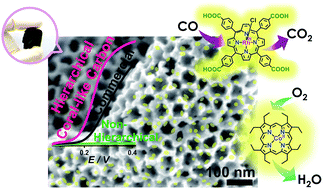Coral-like hierarchical carbon nanoarchitectures loaded with Rh- and Co-porphyrins as high-efficiency electrodes: effect of pore morphology on CO oxidation and oxygen reduction performance†
Abstract
Hierarchically nanostructured, coral-like carbons with uniform spherical ∼50 nm pores and <2 nm wall micropores as well as their non-coral-like, microporous counterparts are loaded with Rh- and Co-porphyrins. Taking advantage of the pore networks with high uniformity and controllability, the performances of these composites in electrochemical CO oxidation (by loading Rh porphyrin) and oxygen reduction reactions (ORRs, by loading Co porphyrin) are compared in a systematic manner to precisely elucidate the pore morphology–performance relationship. The porphyrin-loaded coral-like carbons show significantly higher CO oxidation and ORR currents than their microporous counterparts, with performance improvements attributable to high porphyrin loading (up to 35 μmol g−1) and dispersity ensured by the presence of ∼50 nm pores. The improvement is more distinct for the coral-like carbon with higher pore connectivity (with ca. 15 nm neck) in CO oxidation, while this tendency is somewhat limited in the ORR. Even superior performance to commercial carbon blacks with the same porphyrin loading results, generating ∼2 (CO oxidation, at E = 0.3 V vs. a reversible hydrogen electrode) and ∼3–6 times (the ORR, at E = 0.4 V vs. a reversible hydrogen electrode) higher currents, which is considered indicative of favorable mass-transfer kinetics for the coral-like carbons. The hybrids exhibiting excellent performances are considered to be promising Pt-free electrodes in various electrochemical devices (e.g., fuel cells), while, based on the comparisons, insights into the future design directions of carbon nanoarchitectures for metalloporphyrin-loaded electrodes with further improved performance are provided.



 Please wait while we load your content...
Please wait while we load your content...